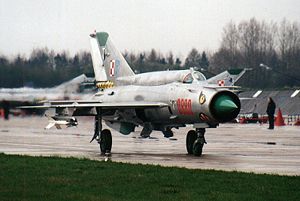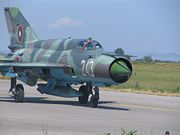Mikoyan-Gurevich MiG-21
| MiG-21 | |
|---|---|
 |
|
| MiG-21bis of 1st Naval Fighter Sqn., Polish Air Force. | |
| Role | Fighter |
| Manufacturer | Mikoyan-Gurevich OKB |
| First flight | 14 June 1956 |
| Introduced | 1959 |
| Primary users | Soviet Air Force Indian Air Force Romanian Air Force Vietnam People's Air Force |
| Number built | 10,352[1] (10,158 produced in the USSR, and 194 in Czechoslovakia) |
| Variants | Chengdu J-7 |
The Mikoyan-Gurevich MiG-21 (Russian: Микоян и Гуревич МиГ-21) (NATO reporting name "Fishbed") is a supersonic jet fighter aircraft, designed and built by the Mikoyan-Gurevich Design Bureau in the Soviet Union. It was popularly nicknamed "balalaika", from the aircraft's planform-view resemblance to the famous Russian stringed musical instrument or ołówek (English: pencil) by Polish pilots due to the shape of its fuselage.[2] Early versions are considered second-generation jet fighters, while later versions are considered to be third-generation jet fighters. Some 50 countries over four continents have flown the MiG-21, and it still serves many nations a half-century after its maiden flight. The fighter has the distinction of holding a number of aviation records, including 1) most produced supersonic jet aircraft in aviation history, 2) most produced combat aircraft since World War II, and 3) longest production run of a combat aircraft. It has been estimated that more than 10,000 MiG-21s were built.[3]
Contents |
Development
The MiG 21 jet fighter was a continuation of Soviet jet fighters, starting with the subsonic MiG-15, MiG-17, and the supersonic MiG-19. A number of experimental Mach 2 Soviet designs were based on nose intakes with either swept-back wings, such as the Sukhoi Su-7, or tailed deltas, of which the MiG-21 would be the most successful.
The E-5 prototype of the MiG-21 was first flown in 1955 and made its first public appearance during the Soviet Aviation Day display at Moscow's Tushino Airport in June 1956. The first delta-wing prototype, named Ye-4 (or E-4) flew on 14 June 1956, and the production MiG-21 entered service in early 1959. Employing a delta configuration, the MiG-21 was the first successful Soviet aircraft combining fighter and interceptor characteristics in a single aircraft. It was a lightweight fighter, achieving Mach 2 with a relatively low-powered afterburning turbojet, and is thus comparable to the American F-104 Starfighter and French Dassault Mirage III.
When the MiG-21 was first introduced, it exhibited several flaws. Its early version air-to-air missiles, the Vympel K-13 (NATO reporting name AA-2 'Atoll'), were not successful in combat, and its gyro gunsight was easily thrown off in high-speed maneuvers, making the initial version of the MiG-21 an ineffective aircraft. These problems were remedied, and during the Middle Eastern and Vietnam wars, the MiG-21 proved to be an effective aircraft. Subsequent MiG-21 models added design modifications to incorporate lessons learned in these wars.
Like many aircraft designed as interceptors, the MiG-21 had a short range. This was not helped by a design defect where the center of gravity shifted rearwards once two-thirds of the fuel had been used. This had the effect of making the plane uncontrollable, resulting in an endurance of only 45 minutes in clean condition. The delta wing, while excellent for a fast-climbing interceptor, meant any form of turning combat led to a rapid loss of speed. However, the light loading of the aircraft could mean that, at 50% fuel and with two Atolls, a climb rate of 58,000 ft (17,670 m) per minute was possible, not far short of the performance of the later F-16A. Given a skilled pilot and capable missiles, it could give a good account of itself against contemporary fighters. It was replaced by the newer variable-geometry MiG-23 and MiG-27 for ground support duties. However, not until the MiG-29 would the Soviet Union ultimately replace the MiG-21 as a maneuvering dogfighter to counter new American air superiority types.
The MiG-21 was exported widely and continues to be used well past the time where it might have been considered obsolete. The aircraft's simple controls, engine, weapons, and avionics were typical of Soviet-era military designs. While technologically inferior to the more advanced fighters it often faced, low production and maintenance costs made it a favorite of nations buying Eastern Bloc military hardware.
Due to the lack of available information, early details of the MiG-21 were often confused with those of the similar Sukhoi fighters also under development. Jane's All the World's Aircraft 1960-1961 describes the "Fishbed" as a Sukhoi design, and uses an illustration of the Su-9 'Fishpot'.
Production

A total of 10,158 (some sources say 10,645) were built in the USSR. They were produced in three factories, in the GAZ 30 in Moscow (also known as Znamiya Truda), in GAZ 21 in Gorky[4] and in GAZ 31 in Tbilisi. The type of "MiG" manufactured differed. Gorky built single-seaters for the Soviet forces. Moscow built single-seaters for export and Tbilisi manufactured the twin-seaters both for export and for the USSR. However, there are exceptions. The MiG-21R and MiG-21bis for export and for the USSR were built in Gorky, 17 single-seaters were built in Tbilisi (probably MiG-21F), the MiG-21MF was first built in Moscow and then Gorky, and the MiG-21U was built in Moscow as well as in Tbilisi. The count for each factory is:
- 5,278(or 5,765) in Gorky
- 3,203 in Moscow
- 1,677 in Tbilisi [5]
Technical description

The MiG-21 is a single-engined jet fighter aircraft capable of supersonic flight. [2] [3]
- Wing
The MiG-21 has a delta wing. The sweep angle on the leading edge is 57° with a TsAGI S-12 airfoil. The angle of incidence is 0° while the dihedral angle is -2°. On the trailing edge there are ailerons with an area of 1.18 m², and flaps with an area of 1.87 m². In front of the ailerons there are small wing fences.
- Fuselage
A semi-monocoque with an elliptical profile with a maximum width of 1.24m. The air flow to the engine is regulated by a cone in the air intake. Up until the MiG-21PF it is three staged. On speeds up to M=1.5 it is fully retracted, between speeds of M=1.5 and M=1.9 it is in the middle position, and with speeds higher than M=1.9 it is in the maximum forward position. However, on the MiG-21PF it adapts to the actual speed, according to the UVD-2M system aboard the aircraft, which monitors the pressure in front and behind the compressor of the engine. On both side of the nose there are gills to supply the engine with more air while on the ground and during takeoff. In the first variant of the MiG-21, the pitot tube is on the bottom of the nose; after the MiG-21P, every version of the -21 has this tube situated on the top of the air intake. The cabin is pressurized and air conditioned. The canopy up until the MiG-21PFM opens on a hinge on the front of the canopy. When ejecting, the SK-1 ejection seat connects with the canopy making a capsule to enclose the pilot and protect him from the airflow, after which it would separate and the pilot would parachute down. However, the canopy took too long to separate and some pilots were killed after ejecting at low altitudes. On the MiG-21PFM the canopy opens on a hinge on the right side of the cockpit. On the belly of the plane there are three air brakes, two at the front and one at the back. The front brakes have an area of 0.76 m², and a deflection angle of 35°. The back one has an area of 0.46 m² and a deflection angle of 40°. The usage of the back air brake is blocked if the plane carries an external fuel tank. Behind the air brakes are the bays for the main landing gear. Under the body, just behind the trailing edge of the wing, two JATO rockets can be attached. The front part of the fuselage ends with former #28. Beginning with former #28a is the back part of the fuselage, which is removable for engine maintenance.
- Empennage
The empennage of the MiG-21 consists of a vertical stabilizer, a stabilator and a small fin on the bottom of the tail to improve yaw control. The vertical stabilizer has a sweep angle of 60° and an area of 5.32 m² (on earlier version 3.8 m²) and a rudder. The stabilator has sweep angle of 57°, an area of 3.94 m² and a span of 2.6m.
- Landing Gear
A tricycle type undercarriage with a nose gear. The main landing gear has tires 800 mm in diameter and 600 mm in width (till the MiG-21P 660x200). The wheels of the main landing gear retract in the fuselage after rotating 87°, the shock absorbers retract in the wing. The nose gear retracts forward in the fuselage under the radar. The wheel base is 4.71 m, the track width is 2.69 m.
- Engines
The MiG-21 engine was produced in several variants.[6]
| Engine | Thrust (kN)[7] | Variant |
|---|---|---|
| R-11F-300 | 38.2/53.4 | F, F-13, U |
| R-11F2-300 | 38.7/60.0 | F-13 (refitted), PF, FL |
| R-11F2S-300 | 38.2/60.6 | PF, PFS, PFM, R, S, M, US, UM |
| R-11F2SK-300 | 38.2/60.6 | MF |
| R-13-300 | 39.9/63.7 | M (refitted), MF, RF, SM, SMT, UM (refitted) |
| R-25-300 | 40.2/69.9 97,1kN with "extreme afterburner" | bis |
Operational history
Vietnam

The MiG-21 initially achieved renown in the Vietnam War, during which it saw frequent action. It was one of the most advanced aircraft at the time; however, many North Vietnamese aces preferred flying the MiG-17, since the high wing loading on the MiG-21 made it less maneuverable than the MiG-17. Although the MiG-21 lacked the long-range radar, missiles, and heavy bombing payload of its contemporary multi-mission U.S. fighters, it proved a challenging adversary in the hands of experienced pilots especially when used in high speed hit and run attacks under GCI control. MiG-21 intercepts of F-105 strike groups were effective in downing US aircraft or forcing them to jettison their bomb loads.
By the bombing halt in Operation Rolling Thunder in 1968, poor air-to-air combat loss-exchange ratios against smaller, more agile enemy MiGs during the early part of the Vietnam War eventually led the USAF to establish Dissimilar Air Combat Training programs such as Navy "Top Gun", these two programs employed subsonic A-4 Skyhawk and F-5 Tiger II aircraft to mimic the performance of more maneuverable opponents like the MiG-17 and MiG-21.
A VPAF MiG-21MF flown by Phạm Tuân over Hanoi, North Vietnam on December 26, 1972 was apparently responsible for the only claimed air combat kill of a U.S. Air Force B-52 Stratofortress in history. The B-52 had been circling above Hanoi during Operation Linebacker II. Over the course of the Vietnam War, between April 26, 1965 and January 8, 1973, each side claimed favorable kill ratios.
Middle East

The MiG-21 was also used extensively in the Middle East conflicts of the 1960s, 1970s and 1980s by the air forces of Egypt, Syria and Iraq against Israel. The MiG-21 first faced Israeli Mirage IIICs on April 7th, 1967 when six Syrian MiG-21's were shot down by the Israeli Mirages. The MiG-21 would face F-4 Phantom IIs and A-4 Skyhawks later in the 1970s, but was later outclassed by the more modern F-15 Eagle and F-16 Fighting Falcon, which were acquired by Israel beginning in the 1980s. The MiG-21 was also used in the early stages of the Soviet invasion of Afghanistan in December, 1979.
Egypt would eventually be shipped some American Sidewinder missiles, and these were fitted to their MiG-21s and successfully used in combat against Libyan MiG-23s during the brief 1977 war.
During the Yom Kippur War, in the "Air Battle of el-Mansoura" Egypt, Israel launched a large scale raid with over 100 aircraft – F-4 Phantoms and A-4 Skyhawks – attempting to hit the huge air base at el-Mansourah. It culminated in an almost continuous dogfight lasting no less than 53 minutes. According to Egyptian estimates over 180 aircraft were involved at one time, the majority belonging to the Israelis. At 10pm local time Cairo Radio broadcast “Communiqué Number 39”, announcing that there had been several air battles that day over a number of Egyptian airfields, that most intensive being over the northern Delta area. It also claimed that 15 enemy aircraft had been downed by Egyptian fighters for the loss of three Egyptian aircraft, while an even greater number of Israelis had been shot down by the Army and the Air Defense Forces over Sinai and the Suez Canal. For its part, Israel Radio claimed, early the following morning, that the IAF had shot down 15 Egyptian aircraft, a figure subsequently reduced to seven. . Following a more detailed analysis after the war had ended, the EAF actually increased its original claims and now asserts that the results of the el-Mansourah air battle were as follows: 17 Israeli aircraft confirmed shot down for the loss of six MiGs. Of the EAF aircraft lost, three were shot down by the enemy, two crashed because they ran out of fuel before their pilots could return to base and a third blew up after flying through the debris of an exploding Phantom which it had just shot down. [8]
India
The Indian Air Force has been one of the largest users of the MiG-21 since its initial employment of the plane in the Indo-Pakistani War of 1971. That war witnessed the first supersonic air combat in the subcontinent when an Indian MiG-21 shot down a PAF F-104 Starfighter.[9] It was also used as late as 1999 in the Kargil War. One MiG-21 was also shot down by Pakistani surface-to-air missiles during the short war.[10] The MiG-21's last known kill took place in 1999 during the Atlantique Incident when two MiG-21 aircraft of the Indian Air Force shot down a Breguet Atlantique reconnaissance aircraft of the Pakistani Navy, which reportedly violated Indian Airspace.[11]
Former Yugoslavia



As the Yugoslavia had drastically improved relations with the Soviet Union during the 60s, in the September 1962 Yugoslav Air Force has received first MiG-21F-13 fighters (in Yugoslav military designated as L-12). In period from 1962 to early 80s Yugoslavia has bought about 216 MiG-21 aircraft in 9 variants - MiG-21F-13 Fishbed-C (L-12), MiG-21U-400 and U-600 Mongol-A (L-12 and NL-12M), MiG-21PFM Fishbed-F (L-14), MiG21US Mongol-B (NL-14), MiG-21R Fishbed-H (L-14i), MiG-21M Fishbed-J (L-15), MiG-21MF Fishbed-J (L-15M), MiG-21UM Mongol-B (NL-16) and MiG-21bis Fishbed-N and Fishbed-L (L-17 and L-17K). From 1964 to 1992 about 80 aircraft have been lost in accidents. Yugoslav Air force units which have operated MiG-21 were 204th fighter-aviation regiment at Batajnica Air Base (126th, 127th and 128th fighter-aviation squadrons), 117th fighter-aviation regiment at Željava Air Base (124th and 125th fighter-aviation squadron and 352nd recon squadron), 83th fighter-aviation regiment at Salatina Air Base (123rd and 130th fighter aviation squadron), 185th fighter-bomber-aviation squadron (129th fighter-aviation squadron) at Pula and 129th training center at Batajnica air base.
During the early stages of the 1991-1995 Yugoslav wars the Yugoslav People's Army used MiG-21s in a ground-attack role, while the separatist forces did not have air forces at beginning of war. Aircraft from air bases in Slovenia, Croatia and Bosnia and Herzegovina were relocated to air bases in Serbia, so MiG-21s left Željava and Pula air bases. Detailed records show at least seven MiGs were shot down by AA defenses in Croatia and Bosnia[12]. One piloted by Emir Šišić shot down a EU helicopter that entered the Yugoslav airspace unannounced.
Croatia acquired three MiG-21s in 1992 through defections by Croatian pilots serving with the JNA, two of which were lost in subsequent actions - one to Serbian air defenses, the other in a friendly fire accident[4]. In 1993, Croatia purchased about 40 MiG-21s in violation of arms embargo[5], but only about 20 of these entered service, while the rest were used for spare parts[6]. Croatia used them alongside the sole remaining defector for ground attack missions in operations Flash (during which one was lost[7]) and Storm. The only air to air action for Croatian MiGs was an attempt by two of them to intercept J-22 Oraos of Republika Srpska Air Force on ground attack mission on 7th of August 1995. After some maneuvering both sides disengaged without having fired a single bullet[8].
All the Yugoslav MiG-21s which have evacuated to Serbia after 1992 have continued their service in the "new" FR Yugoslav Air Force. During the 1999 NATO attack on FRY, Yugoslav Air Force lost 33 MiG-21s[12] on the ground.
Africa
During the Cold War MiG-21s were supplied to many sub-Saharan African nations by the Soviets. Their most notable use in combat occurred during the Angolan Civil War in the hands of the People's Air and Air Defence Force of Angola. Cuban Air Force pilots also flew MiG-21s over Angola during the War. Both Angolan and Cuban MiG-21s often had encounters with South African Air Force Mirages.
The MIG-21s combat record in the Horn of Africa was dismal. During the Ethiopia-Somalia war of 1977-78, American-supplied Ethiopian F-5Es shot down several MIG-21s of the Somali Air Force in dogfights without any air-to-air losses. Ironically, Ethiopia also received the advanced bis version of the MIG-21s which were initially flown by Cuban pilots. Ethiopian F-5Es flew several simulated dogfights against the top Cuban pilots flying the MIG-21s without any losses.[13]
Romania

Beginning in 1993, Russia did not offer spare parts for the MiG-23 and MiG-29 for the Romanian Air Force. Initially, this was the context for the modernization of the Romanian MiG-21's with Elbit systems, and because it was easier for the Romanians to maintain these fighter jets. 110 MiG-21's were modernized under the LanceR designation. Today, only 48 LanceRs are operational for the RoAF. It can use both Western and Eastern armament such as the R-60M, R-73, Magic 2, or Python III missiles. They will be replaced in 2012 when new fighter jets will arrive, such as the F-16, F/A-18, Eurofighter Typhoon, Rafale or Gripen.
Variants



- Ye-2 (NATO: "Faceplate")
- Swept-wing prototype.
- Ye-4 (I-500)
- The first delta wing prototype of the MiG-21.
- Ye-5 (NATO "Fishbed")
- Delta wing research prototype.
- Ye-6
- Three pre-production aircraft.
- MiG-21
- The first series of fighters.
- MiG-21F (NATO: "Fishbed-B")
- Single-seat day fighter aircraft. It was the first production aircraft, with 40 machines being made. The MiG-21F carried 2160 liters of fuel in six internal fuel tanks and was powered by a Tumansky R-11 turbojet engine with 5740kgf of thrust, and armed with two 30-mm NR-30 cannons 60 shells each, it was also capable of carrying two bombs ranging from 50 to 500 kg each. Prototype Ye-6T was redesignated MiG-21F.
- Ye-50
- Swept-wing research prototype.
- Ye-66
- Single-seat version, built for breaking the world speed record.
- Ye-66A
- Built to break the world altitude record.
- Ye-66B
- Rocket-boosted variant built to establish women's time-to-height records.
- Ye-76
- Designation used for MiG-21PFs used to establish women's speed records.
- Ye-150
- Interceptor prototype, essentially an enlarged MiG-21.
- Ye-152 (NATO "Flipper")
- Bigger than a MiG-21, the Ye-152 'Flipper' was a high-performance aircraft, which achieved at least 3 world records.
- MiG-21F-13 (NATO "Fishbed-C")
- Single-seat, short-range day fighter. The MiG-21F-13 was the first mass-production model. The MiG-21F-13 was powered by a Tumansky R-11 turbojet engine, it was armed with two Vympel K-13 (AA-2 'Atoll') air-to-air missiles, and one 30-mm NR-30 cannon with a 30 shell magazine. The Type 74 is the Indian Air Force designation. The MiG-21F-13 was made in China, and designated Chengdu J-7 or F-7 for export.
- MiG-21FL
- Export model of the MiG-21PF. Built under license in India as the Type 77.
- MiG-21I (NATO "Analog")
- Testbed for the wing design of the Tu-144 (NATO: 'Charger') supersonic transport.

- MiG-21SPS
- Version built for East Germany.
- MiG-21P (NATO "Fishbed-D / Fishbed-E")
- Single-seat, limited all-weather interceptor fighter. Armed with two air-to-air missiles only.
- MiG-21PF (NATO "Fishbed-D / Fishbed-E")
- Single-seat, limited all-weather fighter, equipped with a RP21 Sapfir radar. The MiG-21PF is the second production model. Prototype Ye-7, Type 76 Indian Air Force designation.
- MiG-21PF (SPS) (NATO "Fishbed-E")
- MiG-21PFM (NATO "Fishbed-F")
- Single-seat, limited all-weather fighter, with upgraded radar and a more powerful engine. Improved version of the MiG-21PFS.
- MiG-21PFS (NATO "Fishbed-F")
- Single-seat, limited all-weather fighter, with upgraded radar and a more powerful engine.
- MiG-21 (NATO "Fishbed-G")
- Experimental short take-off and landing version of the MiG-21PFM. Two lift engines in lengthened fuselage.
- MiG-21R (NATO "Fishbed-H")
- Single-seat tactical reconnaissance version of the MiG-21PFM.
- MiG-21RF (NATO "Fishbed-J")
- Single-seat tactical reconnaissance version of the MiG-21MF.
- MiG-21S (NATO "Fishbed-J")
- Single-seat interceptor fighter version, equipped with an RP-22 radar and an external gun pod. (Incorrectly identified by NATO as the MiG-21PFMA); E-8, Type 88 Indian Air Force designation.
- MiG-21SM
- Single-seat interceptor fighter version, powered by a Tumansky R-13-300 turbojet engine.
- MiG-21PFV
- High-altitude version (perekhvatchik forsirovannij visotnij, high-altitude boosted interceptor).
- MiG-21M
-
MiG-21MF, Polish Air Force, markings of 3rd Tactical Sqn.
- Export version powered by a Tumansky R-13 turbojet engine. Built under license in India as the Type 96.
- MiG-21MF
- Export version powered by a Tumansky R-13 turbojet engine.
- MiG-21MF (NATO "Fishbed-J")
- Single-seat multi-role fighter version, equipped with a RP-22 radar, powered by a Tumansky R-13-300 turbojet engine.
- MiG-21MF-R
-
 MiG-21SMT of the former Soviet Air Force.
MiG-21SMT of the former Soviet Air Force. - After the MiG-21R was withdrawn from service in the Bulgarian Air force in 1995, a group of engineers fitted the MiG-21MFs with the recon containers from the MiG-21Rs.
- MiG-21SMT (NATO "Fishbed-K")
- Single-seat multi-role fighter version, powered by a Tumansky R-13 turbojet engine. Increased fuel and ECM capability. (E-9, block 94 and 96)
- MiG-21bis (NATO "Fishbed-L")
- Single-seat multi-role fighter and ground-attack aircraft. The final production model built up until 1977 in Russia and 1987 in India. This version is powered by a Tumansky R-25-300 turbojet engine, and carries 2880 liters of fuel. The engines are capable of "extreme afterburner" for up to 3 min - increasing the thrust from 7100 kgf to 9900 kgf. Later MiG-21bis equipped with a nose mounted ILS antenna and upgraded avionics received the NATO designation "Fishbed-N".[9]
- Single-seat multi-role fighter and ground-attack aircraft.
- MiG-21U (NATO "Mongol-A")
- Two-seat training version of the MiG-21F-13. Type 66 Indian Air Force designation.
- MiG-21US (NATO "Mongol-B")
- Two-seat training version. Type 68 Indian Air Force designation.
- MiG-21UT
- Two-seat trainer.
- MiG-21UM (NATO "Mongol-B")
- Two-seat training version of the MiG-21MF. Type 69 Indian Air Force designation.
- JJ-7
- Two-seat training version of the J-7.
- FT-7
- Export designation of the JJ-7.
- MiG-21-93 Bison
- Upgraded version for export and Indian Air Force is the first customer. Armed with Phazotron Kopyo (Spear) airborne radar, which is capable of simultaneously tracking 8 targets and engage 2 of the 8 target tracked with semi-active radar homing air-to-air missile such as Vympel R-27. The radar also enable to fighter to deploy active radar homing air-to-air missile such as Vympel R-77 when additional channel is incorporated. Russian advertise has claimed that this version is equivalent to early F-16. It performed well against F-15 and F-16s of the USAF during Indo-US joint air exercises. In simulated air combat maneuvering the 'Bison' variants managed to win almost all of the mock engagements.
- MiG-21-97
- MiG-21-93 upgrade. MiG-21-93 re-engined with Klimov RD-33 engine. Russians have claimed that the evaluation at Ramenskoye Airport had shown that this version had beaten simulated F-16 in mocked dogfight with a score of 4:1.
- MiG-21 LanceR
-
MiG-21 LanceR 'C' taking off from the RoAF 71st Air Base
- Upgraded version for the Romanian Air Force done by Elbit of Israel and Aerostar of Romania. The LanceR-A version is optimized for ground attack being able to deliver precision guided munitions of eastern and western origin as well as R-60, R-73 and Python III air to air missiles. The LanceR-B version is the trainer version and the LanceR-C version is the air superiority version featuring 2 LCD MFDs, helmet mounted sight and the Elta EL/M-2032 Air combat radar.[10]
- MiG-21MFN
-
 Croatian Air Force MiG-21 bis-D
Croatian Air Force MiG-21 bis-D - Upgraded MF version for the Czech Air force (navigation and communication systems for compatibility with NATO).
- MiG-21bisD/UMD
-
 MiG-21 2000
MiG-21 2000 - Upgraded in 2003 for the Croatian Air force with some elements of the Lancer standard. Modernized for a 10-year period but due to be withdrawn from service in 2011. Reported to have the ability to fire Swedish RBS-15F anti-ship missiles.
- MiG-21-2000
- Single-seat 21st century version for export buyers. Made by Israel Aerospace Industries.
Foreign variants
- China (PRC)
Chinese copies of the MiG-21 are designated Chengdu J-7 and F-7 (for export).
- Czechoslovakia
Between 1962 and 1972 the MiG-21F-13 version was manufactured under license by Aero Vodochody, in Czechoslovakia. Aero Vodochody (then Středočeské strojírny, n.p.), built a total of 194 planes during this period, under the cover designation article Z-159. It followed the MiG-15 and MiG-19S built in Vodochody factory from the fifties to sixties. The sole locally-built version of the MiG-21F-13 differed externally from the Soviet-built examples by the solid dural sheet fairing behind the cockpit canopy, as opposed to the transparent one on the original Soviet MiGs. These machines were built for the Czechoslovak Air Force and also for export. The R-13-300 engines were imported from the Soviet Union.
- India
The production of the MiG-21bis assembled from CKD parts and also reportedly built from scratch in India under license by Hindustan Aeronautics in Nasik lasted until 1984. Despite a series of crashes during the 1990s, which led to the aircraft acquiring the nickname "flying coffin," the Indian Air Force has decided to upgrade about 128 of the MiG-21bis in its inventory to the MiG-21 "Bison" standard. These will serve the Indian Air Force until 2015.
- Israel
Israeli Aircraft Industries manufactures an upgrade package for the MiG-21 called the MiG-21-2000.[14]
- Israel/Romania
A joint venture between Aerostar SA and Elbit has developed the "LanceR" upgrade package for the MiG-21, and 114 MiG-21s have been upgraded to the MiG-21 LanceR configuration for the Romanian Air Force.

- Russia
Russia now offers an upgrade package to bring late-model MiG-21s up to the MiG-21-93 standard. This package provides an upgrade of the avionics suite that includes installation of the Kopyo pulse-doppler radar used by the MiG-29, which enables the aircraft to fire a greater range of modern weapons such as the beyond-visual-range Vympel R-77 air-to-air missile. The upgraded avionics also enhance the aircraft's survivability as well as its ability to engage enemy fighters. Other upgrade features include installation of a dual-screen HUD, helmet-mounted target designator, and advanced flight control systems.
Operators





Current operators
This list does not include operators of Chinese copies / licensed manufactured versions known as the Chengdu J-7.
 Angola
Angola- 25 MiG-21 in service.
 Armenia
Armenia- Armenian Air Force
 Azerbaijan
Azerbaijan- Azerbaijan Air Force. 3 MiG-21 in service.
 Bulgaria
Bulgaria- Bulgarian Air Force. From 1963 to 1990 Bulgaria received: 224 MiG-21s. 36 remain in service.[11]
 Croatia
Croatia- Croatian Air Force. 12 MiG-21bisD/UMD in service.
 Cuba
Cuba- Cuban Air Force. From 1962 to 1983 Cuba received 270 MiG-21 of the following versions: MiG-21F-13, MiG-21PF, MiG-21PFM, MiG-21PFMA, MiG-21U, MiG-21UM, MiG-21MF, MiG-21R and MiG-21bis. 160 remain in service as follows: 90 MiG-21bis, 60 MiG-21MF and 10 MiG-21UM.[12]
 Egypt
Egypt- Egyptian Air Force. 62 MiG-21 in service, to be phased out and replaced by modern fighters by 2010.
 India
India- Indian Air Force. 428 MiG-21Bis and MiG-21MF in service with the Indian Air Force are to be replaced.
 Libya
Libya- Libyan Air Force. 25 MiG-21 in service, purchased from the Soviet Union
 Mali
Mali- 16 in service.
 Mozambique
Mozambique Nigeria
Nigeria- Nigerian Air Force. 32 MiG-21 grounded, to be retired.
 North Korea
North Korea- North Korean Air Force. 150 MiG-21 in service.
 Romania
Romania- Romanian Air Force. 48 MiG-21 currently in service with the Romanian Air Force, to be phased out in 2011, when new fighter aircraft, are purchased.[15]
 Serbia
Serbia- Serbian Air Force. 23 (MiG-21 Bis), 6 (MiG-21 UM) but only 10 in service.[16][17]
 Syria
Syria- Syrian Air Force. 176 MiG-21 in Service.
 Tanzania
Tanzania Turkmenistan
Turkmenistan Vietnam
Vietnam- Vietnam People's Air Force. 124 MiG-21 in service.
 Yemen
Yemen- Yemen Air Force. 47 MiG-21 in service.
 Uganda
Uganda- Ugandan Air Force. Several ex-Polish MiG-21s upgraded by IAI, now in service at Entebbe.
Former operators
 Afghanistan
Afghanistan- Afghan Air Force. 166 total examples, including 70 MiG-21MF, 40 MiG-21F-13, and almost 50 MiG-21bis, were acquired by the Afghan Air Force. The F-13 examples were delivered in 1965, while the remainder were delivered from 1980 on. None remain operational.[18]
 Bangladesh
Bangladesh- Bangladesh Air Force. Received 1 squadron of MiG-21 in 1973. All now retired, instead use Chengdu J-7.MiG-21's in the Bangladesh Air Force
 Algeria
Algeria- Algerian Air Force
 Belarus
Belarus- Belarus Air Force
 Cambodia
Cambodia- Cambodian Air Force. 4 MiG-21s all grounded.
 Republic of the Congo
Republic of the Congo Czechoslovakia
Czechoslovakia- Czechoslovakian Air Force. All aircraft passed on to Czech Republic and Slovakia. Many versions: F-13 (Soviet and Czechoslovak build), PF, PFM, R, MA, MF and two-seat U, US and UM. Never uses Bis version.
 Czech Republic
Czech Republic- Czech Air Force. Last MF was upgraded to MFN NATO standard. No longer in service, replaced by Gripens.
 East Germany
East Germany- East German Air Force. Handed over to the Luftwaffe upon reunification.
 Ethiopia
Ethiopia- Ethiopian Air Force. Type replaced by Su-27s. Fighters: MIG-21bis (1978-2001) along with two seat variant of unknown type.
 Finland
Finland- Finnish Air Force. Fighters: MiG-21bis Fishbed-N (26; 1977-1998), MiG-21F-13 Fishbed-C (22; 1963-1986), Trainers: MiG-21UM Mongol-B (2; 1974-1998), MiG-21US Mongol-B (2; 1981-1997), MiG-21UTI Mongol-A (2; 1965-1997)
 Guinea
Guinea Guinea-Bissau
Guinea-Bissau Hungary
Hungary- Hungarian Air Force. Over 300 examples from 1962 to 2001 (MiG-21MFs grounded in 1996)
 Indonesia
Indonesia- Indonesian Air Force. Acquired its MiG-21s in 1961 and used during the preparation of Operation TRIKORA in 1962 in Western New Guinea (now Papua and Papua Barat). The aircraft were largely grounded in 1969 and removed from service in 1970.
 Iraq
Iraq- Iraqi Air Force. Probably all either destroyed or scrapped, 35 flown over to Iran in 1991.
 Kazakhstan
Kazakhstan Kyrgyzstan
Kyrgyzstan Laos
Laos Madagascar
Madagascar Mongolia
Mongolia North Yemen
North Yemen- MiG-21 passed on to Yemen.
 Poland
Poland- Polish Air Force. 581 MiG-21 in many versions (F-13, PF, PFM, M, R, MF, bis, U, US, and UM) bought in the years 1961-1980, retired in 2003.
 Russia
Russia- Russian Air Force
 Slovakia
Slovakia- Slovak Air Force
 Tajikistan
Tajikistan Soviet Union
Soviet Union- Soviet Air Force and Soviet Anti-Air Defence. MiG-21 passed on to successor states.
 Ukraine
Ukraine- Ukrainian Air Force
 Yugoslavia
Yugoslavia- SFR Yugoslav Air Force. 264 MiG-21 aircraft in 9 versions (F-13, PF, PFM, M, MF, R, bis, US, UM) passed on to successor state: Federal Republic of Yugoslavia.
 Yugoslavia
Yugoslavia- Air Force of the Federal Republic of Yugoslavia / Serbia and Montenegro had three squadrons with MiG-21, but only one Squadron survived the Kosovo War and has been passed on to successor state: Serbia.
 Zambia
Zambia
Civil operators
Some aircraft are now owned and flown by private collectors as warbirds. There are even importers in the U.S. that purchase MiG-21s, MiG-15s and MiG-17s from Russia and other states and sell them to civilians for around $45,000.
Specifications (Mikoyan-Gurevich MiG-21bis)

General characteristics
- Crew: One
- Length: 15.76 m including probe (51 ft 8 in)
- Wingspan: 7.15 m (23 ft 5 in)
- Height: 4.12 m (13 ft 6 in)
- Wing area: 23 m² (247.5 ft²)
- Empty weight: 5,350 kg (11,800 lb)
- Loaded weight: 8,726 kg (19,200 lb)
- Max takeoff weight: 9,660 kg (21,300 lb)
- Powerplant: 1× Tumansky R-25-300 afterburning turbojet, 55 kN (12,370 lb)[19] dry, 70 kN (97 kN with maximum afterburner) (15,700 lbf)
Performance
- Maximum speed: 2230 km/h (1385 mph) (Mach 2.1)
- Range: 1160 km ()
- Ferry range: 1800 km with three external fuel tanks ()
- Service ceiling 19,000 m (62,300 ft)
- Rate of climb: 225 m/s (23,600 ft/min but with 50 per cent fuel and two AA-2 "Atoll" missiles, the MiG-21 can reach 58,000 feet [17,600 meters] in one minute which results in 293 m/s average at different altitudes, under favorable weather circumstances)
- Wing loading: 379 kg/m² (77.8 lb/ft²)
- Thrust/weight: 1.02 at max. takeoff weight, 1.13 at loaded weight with max. afterburner
Armament
- One centerline twin-barrelled GSh-23 23 mm cannon , 200 rounds (PFM, MF, SMT, and bis variants) or one single-barrelled NR-30 cannon ,60 rounds (F-13 variant).
- Up to 2,000 kg (4,400 lb) of air-to-air and air-to-ground weapons on two or four underwing hardpoints, depending on the variant. Early machines carried two Vympel K-13 (AA-2 'Atoll') air-to-air missiles under the wing pylons. Late models carried two K-13 and two fuel tanks under the wing pylons or combinations of four K-13 infrared- and radar-guided missiles. The Molniya R-60 (NATO reporting name AA-8 'Aphid') was also used on multiple pylons and six of them could be carried. Most aircraft carried a single 450 L (119 US gal) fuel tank on the centerline pylon.
See also
- 2002 Jalandhar India MiG-21 crash
- Munir Redfa
- Flight airspeed record
- Doru Davidovici, Romanian Air Force pilot and writer, in whose narrative MiG-21 is seen as an actual character.
Related development
- Chengdu J-7
Comparable aircraft
- English Electric Lightning
- Dassault Mirage III
- Lockheed F-104 Starfighter
- McDonnell Douglas F-4 Phantom II
- Northrop F-5 Freedom Fighter/Tiger II
Related lists
- List of military aircraft of the Soviet Union and the CIS
- List of fighter aircraft
References
- ↑ MIG-21 Fishbed from Russian Military Analysis
- ↑ http://lotniczapolska.pl/MiG-21-%E2%80%93-naddzwiekowy-olowek-,231
- ↑ MiG-21 FISHBED, GlobalSecurity.org
- ↑ Now called Nizhny Novgorod.
- ↑ [1]
- ↑ Engines of the MiG-21
- ↑ without/with afterburner
- ↑ AirEnthusiast, Volume 100 (July/August 2002)
- ↑ The 1971 Liberation War: Supersonic Air Combat (Bharat-Rakshak.com)
- ↑ Indian pilot 'killed in cold blood'
- ↑ Atlantique Incident has complete details with sources.
- ↑ 12.0 12.1 Avijacija bez granica web site dedicated to JNA and successor air forces, containing detailed info on each documented air loss (Serbian)
- ↑ Cuban Defector Recalls Life as a Top Officer - New York Times
- ↑ Airforce Technology.com article
- ↑ Romania replaces the MiG-21, Antena 3, 16th May 2007 (Romanian)
- ↑ Serbian Mig-21 Types
- ↑ http://en.wikipedia.org/wiki/Serbian_Air_Force#Current_status
- ↑ "Historical Listings", World Air Forces.
- ↑ Globalsecurity.org: War in Afghanistan
Bibliography
- Gordon, Yefim. Mikoyan-Gurevich MiG-15: The Soviet Union's Long-Lived Korean War Fighter. Hinckley: Midland, 2001. ISBN 1-85780-105-9.
- Gordon, Yefim. Mikoyan MiG-21 (Famous Russian aircraft). Hinckley: Midland, 2007. ISBN 1857802578.
- Toperczer, István. MiG-21 Units of the Vietnam War (Osprey combat aircraft, 29). Oxford: Osprey Pub, 2001. ISBN 1841762636.
External links
- MiG-21.de
- MIG-21 Fishbed from Russian Military Analysis
- MiG-21 FISHBED from Global Security.org
- MiG-21 Fishbed from Global Aircraft
- Cuban MiG-21
- Cuban MiG-21 in Angola
- Aviation forum to which members have contributed photographs of MiG-21s
- Warbird Alley: MiG-21 page - Information about privately-owned MiG-21s
- African flown MiGs, including the MiG-21
|
|||||||||||||||||
|
||||||||||||||